
Many people know Leonardo da Vinci, but you might still wonder exactly what made him important.
He became famous because he was a brilliant artist, a talented scientist, an engineer, and an inventor who shaped history in many fields. His most well-known works include the Mona Lisa and The Last Supper, clever machines, and detailed notebooks that influenced generations.
His curiosity and unique way of thinking made him a true Renaissance man. If you are interested in his art, inventions, or life story, this article will give you the answers you need.
The Life and Times of Leonardo da Vinci in the Renaissance
Leonardo da Vinci’s life and work give us a window into the creative heart of the Renaissance. His curiosity and drive touched every field, from painting and sculpture to science and engineering.
Leonardo da Vinci’s Biography and Early Years in Florence
Leonardo da Vinci was born in 1452 near the village of Vinci in Italy. He was raised in Florence, one of the key centers of the Italian Renaissance, and started his artistic training as an apprentice to the painter Andrea del Verrocchio.
During his years in Florence, Leonardo learned essential drawing, sculpture, engineering, and mechanics skills. The young artist gained a reputation for his creative ideas and keen observation of nature.
By his early twenties, Leonardo’s notebooks showed his broad interest in mathematics, anatomy, and architecture. He developed his love for sketching and kept careful records in his journals.
These journals later became the most valuable resources for understanding Renaissance creativity and invention.
The Influence of the Quattrocento and High Renaissance on Leonardo da Vinci
The Quattrocento, a term describing the 1400s in Italy, saw a surge in innovation, especially in art and science. Florence was a center of this activity, and Leonardo absorbed the ideals of realism, perspective, and proportion.
As the High Renaissance started, artists sought technical excellence and emotional depth. Leonardo became a leader in this era, using techniques like sfumato to create soft transitions between light and shadow.
This technique appears in works such as the Mona Lisa. Leonardo studied other masters and combined their strengths with his vision.
He focused on anatomy and the accurate depiction of the human body, which is seen in masterpieces like the Vitruvian Man. His work shaped the direction of art history and set new standards for future artists across Europe.
Leonardo da Vinci’s Patrons and Their Role in His Career
Patrons played a significant role in Leonardo’s success. During his career, he worked for powerful families and rulers, including the Medici family in Florence and later Ludovico Sforza, the Duke of Milan.
These sponsors supplied Leonardo with resources and commissions to create grand artworks and engineering projects. While in Milan, Leonardo designed weapons, theaters, and festivals for Sforza and produced The Last Supper for Santa Maria delle Grazie.
After leaving Milan, he worked as a military engineer for Cesare Borgia and then for the King of France. Without support from these patrons, Leonardo may not have had the freedom or funding to pursue his wide range of interests.
How Observation and Nature Shaped Leonardo da Vinci’s Genius
Leonardo da Vinci’s genius grew from a lifelong habit of careful observation. He spent long hours outdoors, drawing animals, plants, and landscapes in his notebooks.
His human and animal anatomy studies helped him become one of the first artists to use science to improve his art. Leonardo’s sketches and detailed notes show his fascination with movement, water, and flight mechanics.
He drew detailed designs of machines, from early flying devices to water pumps. His notebooks are filled with ideas, demonstrating how observation and nature inspired his studies and inventions.
By focusing on the natural world, Leonardo developed a unique approach to problem-solving, mixing art and science. This practice made him stand out among his peers and led to innovations in nearly every activity he touched.
Leonardo da Vinci’s Historical Significance and Cultural Impact
Leonardo da Vinci left a mark as a painter, inventor, scientist, and endless student of curiosity. His masterpieces, including the Mona Lisa, The Last Supper, and the Vitruvian Man, are known worldwide and have shaped how people think about creativity and art.
Leonardo influenced painting, sculpture, anatomy, engineering, and architecture. His scientific approach set him apart from others in the Renaissance.
Today, his vision, notebooks, and legacy are studied in museums and classrooms. Leonardo’s ability to combine different fields and his belief that art and science are connected define his historical significance and lasting cultural impact.
Leonardo da Vinci as a Master Painter and Artist
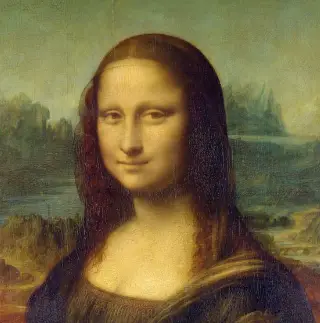
Leonardo da Vinci is celebrated for his achievements as a painter. He used innovative methods to bring depth, emotion, and realism to his works.
His paintings, drawings, and notebooks have greatly impacted art history. They inspired generations of artists and changed how people see art and science.
The Artistic Techniques of Leonardo da Vinci, Including Sfumato and Perspective
Leonardo da Vinci used techniques that stood out during the High Renaissance. Sfumato is one of his most famous methods.
This technique blends colors and lines softly, creating smooth transitions between light and shadow. Faces and backgrounds look more lifelike with this gentle, smoky effect, which you can see clearly in the Mona Lisa.
He also mastered perspective, adding depth to his paintings by making distant objects appear smaller and lighter in color. Leonardo’s keen observation of nature and the use of geometric rules helped his scenes look more realistic.
His attention to proportion and space made his compositions feel balanced and natural. This was new for his time and set the standard for later artists.
Exploring Leonardo da Vinci’s Masterpieces: Mona Lisa and The Last Supper
Leonardo da Vinci’s masterpieces are recognized worldwide. The most famous is the Mona Lisa, painted in Florence.
The subtle smile, soft gaze, and realism are examples of his artistic genius. Many art lovers visit the Louvre Museum in Paris yearly to see her.
Another key work is The Last Supper, a mural located in Milan. Leonardo shows this painting when Jesus tells his disciples that one will betray him.
He arranges the figures dramatically, capturing emotion and story in a single scene. Both works highlight his technical skill, careful use of light, and ability to show deep feelings.
The Role of Drawing, Sketches, and Notebooks in Leonardo da Vinci’s Art
Drawings and sketches were essential tools in Leonardo’s creative process. His notebooks are filled with thousands of sketches, plans, and ideas.
These include quick studies of human faces, animals, plants, and machines. His notebooks show how he explored anatomy, mechanics, and water movement.
Leonardo’s habit of carrying notebooks allowed him to record every observation quickly. This practice connected his roles as artist, inventor, and scientist.
He often studied parts of the body and made detailed sketches that helped him achieve realistic effects in his paintings. His notebooks serve as a window into his mind, bridging the gap between art and science.
Leonardo da Vinci’s Style, Creativity, and Influence on Art History
Leonardo’s unique style marks his art, which focuses on observation. He keenly observed nature and people and used these insights to bring realism and dynamism to his works.
His commitment to careful study led to a new standard for future artists during the High Renaissance. His creativity went far beyond painting.
Leonardo designed inventions, engineering projects, and anatomical studies that showed his broad interests. He influenced painters like Raphael and inspired countless others after.
His ideas about the connection between art and science changed people’s understanding of both fields. Leonardo da Vinci’s biography reveals the depth of his legacy as a visionary artist and thinker.
Portraits and the Use of Anatomy in Leonardo da Vinci’s Artistic Techniques
Leonardo da Vinci’s artistic techniques often began with the careful study of anatomy. He dissected human and animal bodies to understand muscles, bones, and movement better.
This knowledge helped him create portraits and figures that showed true life and emotion. Leonardo’s precise understanding of the body shapes the hands and face in the Mona Lisa.
Carefully drawn lines and soft shading add to the depth and expression in his paintings. Leonardo’s work on anatomy, including sketches like the famous Vitruvian Man, changed portrait painting and influenced artists for many years.
His combination of science and art is the main reason for his lasting fame.
Leonardo da Vinci, the Inventor and Engineer
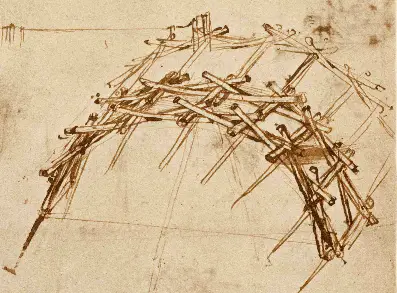
Leonardo da Vinci made groundbreaking discoveries in engineering and invention during the Renaissance. His creativity, careful observation, and scientific methods led to designs and sketches that inspire art history and technology today.
Overview of Leonardo da Vinci’s Engineering Projects and Designs
Leonardo da Vinci worked on many engineering projects during his lifetime. As an inventor and engineer, he designed complex machines, from early flying devices to weapons of war and architectural wonders.
His projects included ideas for a helicopter and an armored tank. He also designed advanced canal systems and drew detailed blueprints for bridges, water pumps, and mechanical tools.
Many of these machines were so advanced that people in the 15th century could not build them. His sketches showed the reach of his imagination and technical skill.
Leonardo’s detailed drawings and notes helped future inventors and engineers explore new possibilities. His engineering work is still admired for its beauty and vision.
How Leonardo da Vinci’s Scientific Approach Fueled His Innovation
Leonardo da Vinci’s scientific approach differed from others during the High Renaissance. He did not simply rely on common beliefs.
He observed nature directly and tested his ideas with experiments and detailed sketches. He studied how water flows, birds fly, and the human body works.
He applied his knowledge of anatomy and perspective, gained from his artistic training, to his inventions and machines. This careful mix of science and art helped him create lifelike drawings and practical ideas.
Leonardo focused on observation and experience. He once said, “Experience is the mother of all certainty.”
This method allowed him to understand problems and create clever, realistic designs deeply.
The Visionary Inventions of Leonardo da Vinci and Their Modern Impact
Leonardo da Vinci’s inventions were far ahead of his time. He created plans for flying machines, like an early version of the helicopter and glider, centuries before modern aviation began.
His designs for mechanical knights, diving suits, and a simple robot showed his vision for what machines could do. Some of his concepts, such as the parachute and tank, were later developed by others using new materials and knowledge.
Today, people study his inventions as early examples of engineering thinking. His studies on water movement help us understand hydraulics.
Leonardo da Vinci’s Methods and Experiments in Science and Engineering
Leonardo da Vinci based his methods on direct observation and testing. He took careful notes, made drawings from many angles, and experimented with materials.
He built working models of some devices to check their functions, such as his famous gears, pulleys, and lever designs. He also studied flight by watching birds and bats, analyzing their wing shapes, and copying their movements in his flying machines.
Leonardo broke down complex problems into simple steps. He also studied human anatomy, using dissection and sketches to learn about bones, muscles, and organs.
This helped his artwork, like the “Vitruvian Man,” and his mechanical designs.
Leonardo da Vinci’s Notebooks: A Window into His Inventive Mind
Leonardo da Vinci’s notebooks are some of the most valuable historical records from the Quattrocento and High Renaissance. They contain thousands of pages of sketches, diagrams, inventions, and notes, written in a unique mirrored script.
Inside his notebooks are plans for machines, studies of anatomy, observations about weather, and even simple lists of tasks. Many famous works, such as the “Vitruvian Man,” appear alongside tools, bridges, and weapon designs.
These notebooks give a step-by-step look into how Leonardo thought and worked. His mix of artistic technique, precise observation, and inventive ideas helped shape his legacy.
The notebooks remain a key part of Leonardo da Vinci’s biography and show the depth of his curiosity and skill.
Leonardo da Vinci’s Multifaceted Genius Beyond Painting
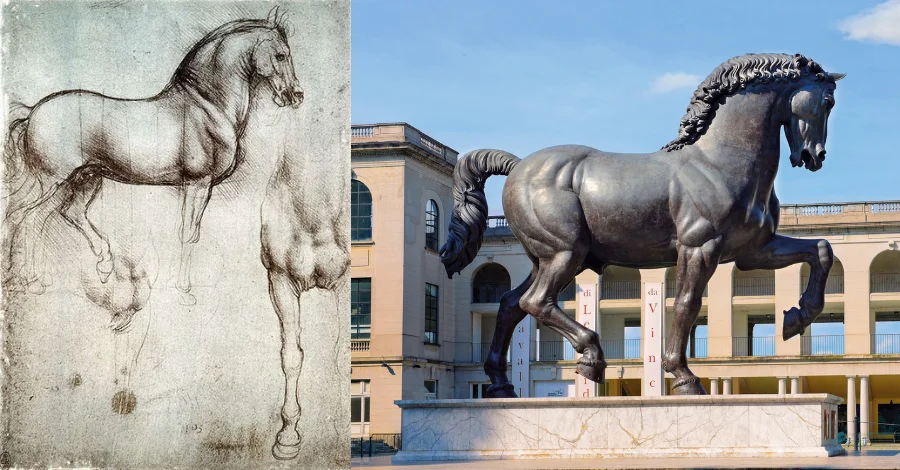
Leonardo da Vinci’s talents reached far beyond his paintings. He played important roles in sculpture, music, architecture, and science.
His work in anatomy and invention still influences people today.
Leonardo da Vinci as a Sculptor, Architect, and Musician
Leonardo da Vinci was not only a painter but also a skilled sculptor, architect, and musician. His work as a sculptor included plans for large equestrian statues, although many of these projects were never completed.
One of his most famous unfinished projects was a massive bronze horse for Duke Ludovico Sforza in Milan. This plan showed his ambition and artistic skill.
As an architect, he designed buildings, fortresses, and urban plans. His sketches and notebooks include drawings of impressive cathedrals and inventive bridges.
Leonardo’s architectural ideas focused on proportion, symmetry, and harmony, following the ideals of the Renaissance.
He also played and composed music. Leonardo played the lyre and often entertained patrons in Florence and Milan.
His talent in music matched his art, blending mathematics, creativity, and science into every note. His ability to master so many fields is one reason people see him as a true Renaissance genius.
The Role of Anatomy Studies in Leonardo da Vinci’s Scientific Research
Leonardo da Vinci’s interest in anatomy changed both art and science. He spent years studying the human body through careful hospital observation and dissection.
His detailed drawings of muscles, bones, and organs became some of the most accurate anatomical sketches of his time. These anatomy studies helped Leonardo create masterpieces like the Vitruvian Man.
He wrote hundreds of pages in his notebooks describing the structure of the human body. Leonardo improved his sfumato and perspective techniques by focusing on how the body moved and functioned.
His portraits and paintings became more lifelike. Leonardo’s scientific approach set him apart from other artists of the High Renaissance.
Leonardo da Vinci’s Contributions to Art, Science, and Technology
Leonardo da Vinci’s inventions and notebooks show a mind eager to solve problems. He designed flying machines, war devices, and hydraulic engineering projects.
His ideas were far ahead of his time, including sketches of helicopters, tanks, and detailed machines. Leonardo developed techniques such as sfumato (the soft blending of colors and edges) and mastered perspective in art.
He gave depth and realism to works like the Mona Lisa and The Last Supper. His light, shadow, and proportion experiments influenced art history for centuries.
Leonardo also wrote about weather, geology, and anatomy. His wide-ranging interests and experiments are part of his reputation as a visionary inventor and scientist.
He worked for some of Europe’s most powerful patrons, always searching for new challenges.
How Leonardo da Vinci Balanced Creativity and Observation in His Work
Leonardo da Vinci combined careful observation with bold creativity. He often observed nature for hours, recording plants, water, clouds, and animal movement in his notebooks.
He wanted to understand how the world worked to improve his art and inventions. His painting methods depended on watching how light touched different surfaces.
Leonardo used observation to guide his brushstrokes, creating new techniques that made his portraits stand out. By patiently sketching and taking notes, he turned what he saw in nature into masterpieces admired worldwide.
His experiments often linked art, science, and engineering, blending knowledge from many subjects. His notebooks are full of drawings and sketches that reveal his imagination and attention to detail.
Leonardo da Vinci’s Legacy as a Visionary Across Disciplines
Leonardo da Vinci is remembered as much more than a painter or artist. His influence stretches across art, science, engineering, and even music.
Because of his work in so many fields, he is often called the model “Renaissance man.” Art historians still study his paintings, drawings, and innovative methods.
His anatomical studies changed how artists painted the human figure. His inventions inspired later engineers and scientists.
Leonardo’s approach—using both creativity and scientific observation—continues to inspire researchers, inventors, and artists. His legacy as a visionary endures, showing what can happen when curiosity and skill cross boundaries.
Understanding Leonardo da Vinci’s Enduring Legacy Today
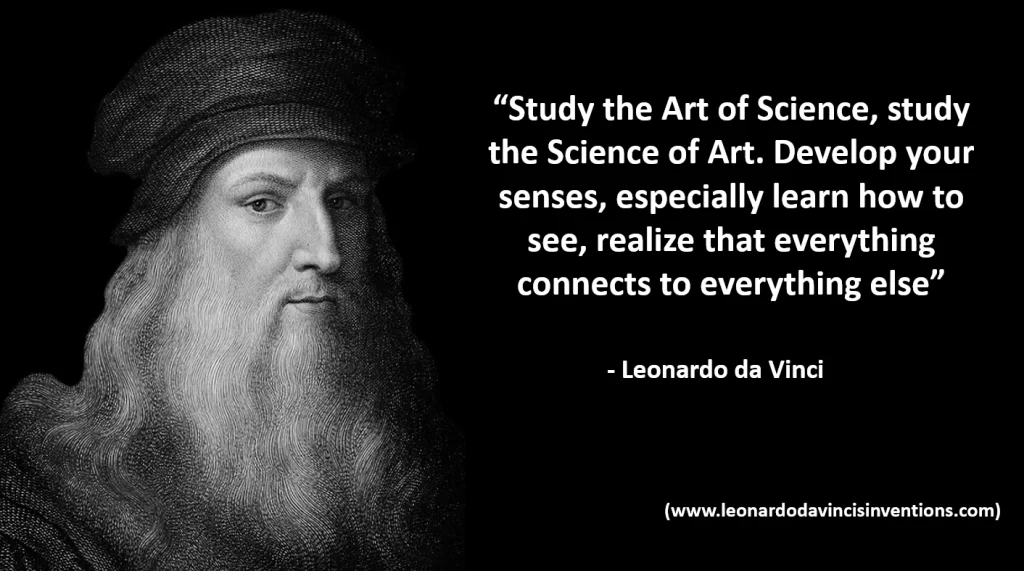
Leonardo da Vinci is recognized for timeless masterpieces like the Mona Lisa and groundbreaking work in anatomy, engineering, and science.
His creative vision, deep studies, and innovative inventions have shaped art history and modern thought for over five hundred years.
The Cultural Impact of Leonardo da Vinci’s Artworks and Inventions
Leonardo da Vinci’s influence reaches far beyond painting. His creations, such as The Last Supper and the Mona Lisa, helped define the High Renaissance and set new standards for portrait and religious art.
He achieved a lifelike quality and realism using techniques like sfumato and perspective. He was an accomplished inventor and engineer, sketching designs for machines and devices that foreshadowed modern helicopters, tanks, and anatomical tools.
Today, museums and science centers often display replicas of his inventions and notebooks. His artworks and designs remain culturally significant and widely studied, as seen in global exhibitions.
Modern scholars point to da Vinci’s broad interests and skills as proof of his genius. His notebooks, detailed observations, and experiments help deepen our understanding of Renaissance culture and creativity.
Why Leonardo da Vinci Remains a Symbol of Genius and Innovation
Leonardo da Vinci is known as the ultimate “Renaissance man” because he mastered many fields. He was a painter, engineer, inventor, architect, and musician.
He linked art and science in ways few others have done. Da Vinci’s curiosity drove him to study everything, from water movement to birds’ flight.
He came up with ideas for inventions far ahead of his time, though not all were built while he lived. Major art and science institutions often highlight his work and life story, inspiring students and professionals.
His discipline, sharp observation, and belief in learning through experience helped define his legacy as a genius. These traits still guide education, research, and creative professions today.
Leonardo da Vinci’s Influence on Modern Art, Science, and Engineering
Leonardo’s style and methods influenced later artists and scientists. Today’s artists study his use of light, anatomy, and sketching techniques.
Many engineering and architectural advances build on da Vinci’s designs and creative projects. Scientists and doctors see his anatomical sketches as a significant step in modern medicine.
His detailed studies of the human body influenced anatomy books for centuries. Engineers study his machines because notebooks show a rare blend of creativity and method.
Many art and science museums display da Vinci’s works and inventions. They present him as a key figure who bridges creativity and practical innovation.
Famous Leonardo da Vinci Quotes That Reveal His Philosophy
Leonardo da Vinci’s quotes reveal his thoughts on creativity, nature, and learning:
- “Learning never exhausts the mind.”
- “Simplicity is the ultimate sophistication.”
- “Art is never finished, only abandoned.”
- “The noblest pleasure is the joy of understanding.”
- “Nature is the source of all true knowledge.”
These quotes show his belief in constant learning, careful observation, and a close connection to nature. He encouraged others to look deeper and seek knowledge in all areas of life.
How Leonardo da Vinci’s Studies Continue to Inspire Creativity and Discovery
Leonardo da Vinci’s engineering, anatomy, and flight studies still spark curiosity in students, artists, and inventors. His approach—careful observation, drawing, and hands-on experiments—sets a strong example for anyone exploring new ideas.
Many classrooms use his notebooks and artwork to teach about the connection between music, art, science, and technology. Teachers show how da Vinci explored every subject, from the structure of plants to complex machines, by drawing what he saw and testing his theories.
Modern inventors and engineers consider da Vinci’s legacy a model of creativity mixed with discipline. His methods and inventions inspire discoveries in both art and science.
Frequently Asked Questions
Leonardo da Vinci is one of the most famous Renaissance figures. He is celebrated for his art, inventions, and scientific ideas. Many details about his life and works continue to spark curiosity today.
What is Leonardo da Vinci best known for?
He is best known as the painter of the Mona Lisa and The Last Supper. His work combined art and science, making him a symbol of the Renaissance.
His notebooks include detailed sketches of inventions and studies of the human body.
Did Leonardo da Vinci have ADHD?
No official diagnosis exists since ADHD was not defined in his time. Some historians suggest he may have shown signs of ADHD, like difficulty finishing projects, based on his scattered work habits.
What caused Leonardo da Vinci’s death?
Leonardo da Vinci died in 1519 at age 67. Most reports say he died after a stroke, though other details of his final sickness are not precise.
Did Da Vinci have children?
He did not marry or have any known children.
Where is Mona Lisa buried?
The Mona Lisa refers to the famous painting. The woman in the painting, Lisa Gherardini, is said to be buried in Florence, Italy.
What was Leonardo da Vinci’s IQ?
There is no way to measure his IQ, as modern IQ tests did not exist during his lifetime. Experts agree Leonardo was knowledgeable, but any specific number is a guess.
Why is Mona Lisa so famous?
The Mona Lisa is famous for her mysterious smile, lifelike presence, and Leonardo’s unique painting techniques. The painting also became well-known after being stolen in 1911 and recovered, which brought global attention.
Who painted The Starry Night?
The Starry Night was painted by Vincent van Gogh, not Leonardo da Vinci. Van Gogh was a Dutch artist from a later period.
What are 5 interesting facts about da Vinci?
- Leonardo could write with one hand and draw with the other simultaneously.
- He designed flying machines and inventions, many of which were never built in his lifetime.
- He carefully studied the human body through dissections.
- He kept many notebooks full of sketches and ideas.
- Leonardo worked as an engineer, architect, and scientist during his life.
How did da Vinci learn so much?
Leonardo was naturally curious and taught himself about many subjects by observing, experimenting, and reading. He also trained as an apprentice to the painter Andrea del Verrocchio in Florence.
How many da Vinci paintings exist today?
Only about 15 to 20 paintings by Leonardo exist today. Some are unfinished or have been badly damaged.
Was da Vinci religious?
Leonardo was raised Catholic, the main religion in Italy at the time. He studied theology and painted many religious scenes.
However, his personal beliefs remain complicated and private.
Where is da Vinci buried?
He is buried in the Chapel of Saint-Hubert at Château d’Amboise in France.
Where is the Mona Lisa?
The Mona Lisa is displayed at the Louvre Museum in Paris, France. You can see it in person when you visit the museum.

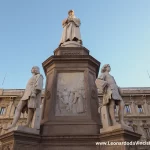
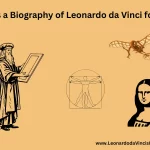
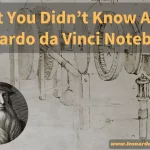
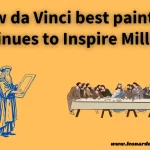
 Leonardo Bianchi,
the creator of Leonardo da Vinci's Inventions.
Thank you for visiting
Leonardo Bianchi,
the creator of Leonardo da Vinci's Inventions.
Thank you for visiting